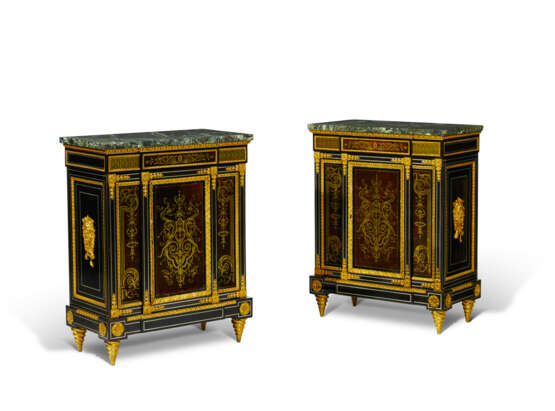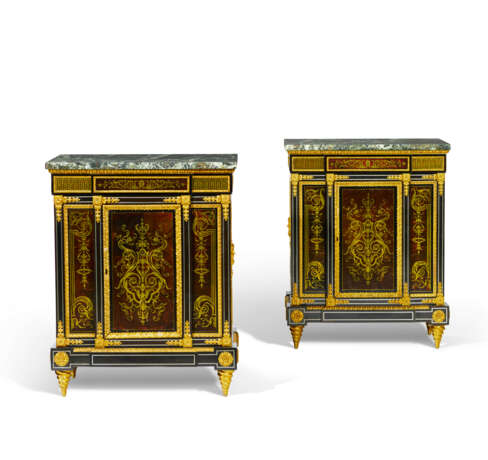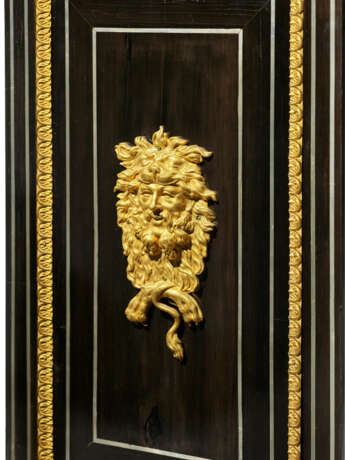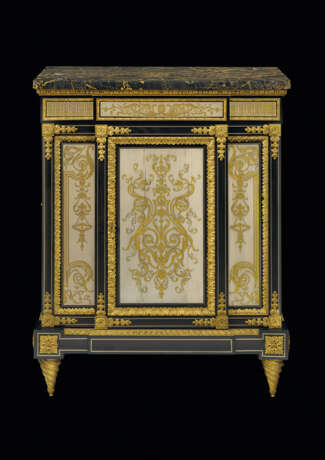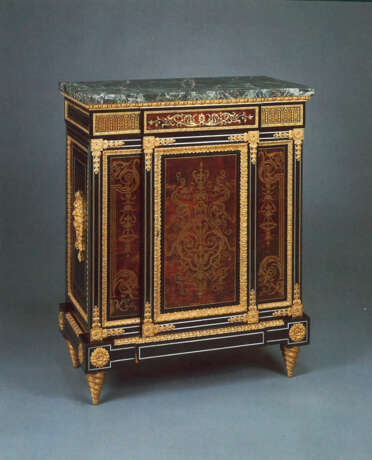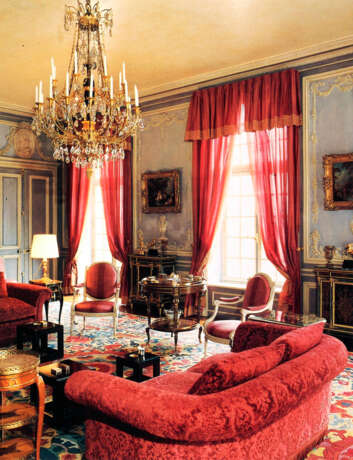ID 1329883
Лот 30 | PAIRE DE MEUBLES D'APPUI D'ÉPOQUE LOUIS XVI
Оценочная стоимость
€ 200 000 – 300 000
L'UN ESTAMPILLÉ D'ÉTIENNE LEVASSSEUR, VERS 1770, L'AUTRE DE LA FIN DU XVIIIe - DÉBUT DU XIXe SIÈCLE
En placage d'ébène, marqueterie Boulle d'écaille de tortue caouanne et de tortue à écailles imbriquées, incrustation de laiton et ornementation de bronze ciselé et doré, le plateau de marbre vert-de-mer, la ceinture ornée à décor de rinceaux feuillagés et cannelures simulées, la façade à ressaut central ouvrant par deux vantaux découvrant une étagère, à décor d'enroulements de feuillages et d'entrelacs, ceint de frises de rais-de-coeurs et de feuilles d'acanthe, les côtés appliqués de masques d'Hercule, sur des pieds toupie, l'un estampillé 'É. LEVASSEUR' sur le montant gauche, quelques remplacements dans les bronzes
H. 98 cm. (38 ½ in.) ; L. 77,5 cm. (30 ½ in.) ; P. 41,5 cm. (16 1/3 in.)
Etienne Levasseur, reçu maître le 17 septembre 1767.
Provenance
Collection Jaime Ortiz Patiño (1930-2013), vente Sotheby’s, New York, 20 mai 1992, lot 88.Collection privée.
Galerie Aveline, Paris, 1996
Further details
MATCHED PAIR OF LOUIS XVI ORMOLU-MOUNTED EBONY, TORTOISESHELL AND BRASS BOULLE MARQUETRY MEUBLES D'APPUI, ONE STAMPED BY ETIENNE LEVASSEUR, CIRCA 1770, THE OTHER ONE LATE 18TH - EARLY 19TH CENTURY
André-Charles Boulle as a model
This pair of meubles d’appui is Etienne Levasseur's personal adaptation of the marquetry cabinets on pedestal made by André-Charles Boulle around 1700. Among the few surviving cabinets is the pair centred on the figure of Louis XIV in the Musée du Louvre (OA5468). Our pair was most probably inspired by cabinets such as the one in the Victoria & Albert Museum, in the Jones collection (1118.1882.1-2), which was itself separated from its pedestal and transformed into a piece of furniture. Our pair has the same ornamental scheme: on the front, a small central recessed leaf is underlined by a rich gilded bronze ornament that seems to extend the inlaid foliage. The central marquetry, featuring motifs characteristic of André-Charles Boulle's designs, is almost certainly a re-employment from the 17th century cabinetmaker's workshop.
This pair illustrates the renaissance of Boulle's work during the reign of Louis XVI, which was directly linked to the rise of Neoclassicism. This resurgence of interest led to a new direction in the production of Parisian furniture in the second half of the 18th century. Etienne Levasseur trained with one of the sons of André-Charles Boulle, who shared his father's name and was nicknamed ‘Boulle de Sève’. He set up as a privileged worker on rue du faubourg Saint-Antoine, at the ‘Cadran bleu’ sign. After marrying the daughter of a cabinetmaker, he became a master on 2 April 1767 under the conditions of favour granted to the master's son-in-law. During the reign of Louis XVI, Levasseur devoted part of his time to copying and repairing Boulle's marquetry. The Court commissioned works from him for the châteaux of Versailles and Saint-Cloud, and he carried out major works for Mesdames Adélaïde and Madame Victoire at the Château de Bellevue, as well as for the King's aunts and wealthy amateurs such as the farmer-general Mulot de Pressigny. The production of Boulle marquetry furniture in his workshop continued until the Restoration and under the reign of Louis Philippe, through the intermediary of his son and then his grandson.
An interpretation by Etienne Levasseur
Although Etienne Levasseur drew his inspiration from the works of André-Charles Boulle, the design of this pair of meubles d’appui is entirely his own. In keeping with the contemporary neoclassical style, it no longer has the leafy lion's paws or the particularly baroque frame with multiple mouldings of the Boulle cabinet in the Victoria & Albert Museum (1118.1882.1-2), but straight mouldings and corner brackets. These corner brackets are, however, inspired by those on Boulle's bas d'armoire, known as the ‘Seasons’, in the Château de Versailles (V2318 to 2321). Unlike Boulle's furniture, these base units no longer have drawers, but a leaf revealing shelves on racks. The leaf no longer corresponds to the recessed panel, as in Boulle's work, but encompasses the central panel and the right-hand side panels and pivots on the outer edge of the cabinet base using hinges concealed on the lower and upper panels. Similarly, while Boulle's cabinets are generally not topped by a belt, this pair of supporting units simulates a false drawer. While the central marquetry panels are probably reused from the 17th century, the friezes of canals and tigettes are reminiscent of 18th century neoclassical friezes. Finally, unlike Boulle's cabinets, the sides of the piece have no marquetry and are replaced by an ebony veneer with a high relief of the mask of Hercules wearing the skin of the Nemean lion. This mask, which is not part of André-Charles Boulle's repertoire, is of modern design.
The sober, elegant lines of this pair of meubles d’appui have none of the baroque silhouettes of Boulle's furniture, and may even reveal a certain influence from Jean-Henri Riesener.
In the manner of Boulle's furniture, separated from its base in the 18th century, covered in marble and placed on a modern plinth, Etienne Levasseur has placed the body of these pieces of furniture on a platform, slightly overhanging, the corners of which are marked by projecting legs decorated with a rosette. It rests on four snail-shaped legs, a model used by Boulle for many consoles and chests of drawers. The design of this type of plinth, which can be found on most seventeenth-century cabinets transformed into support furniture under Louis XVI, including the one in the Victorian Museum mentioned above (1118.1882.1-2), was often made by marchands-merciers.
The role of the marchand-mercier Claude-François Julliot
Levasseur's furniture inspired by the work of André-Charles Boulle was often produced in collaboration with the marchand-mercier Claude-François Julliot. From one of the most important merchants in Paris, rue Saint-Honoré, he was one of the first merchants to undertake the production of furniture inspired by models from the Grand Siècle. He specialised in ‘paintings in stone from Florence and furniture in boulle marquetry and other materials carefully made to the design and ornamental taste of this skilful artist’ (Lugt 2740, Sale after the death of Julliot's wife, 20 November 1777. ‘Précis’ in the catalogue, p. 5). Claude-François Julliot then called on Levasseur either to repair Boulle's original furniture or to create new pieces based on the re-use of old marquetry, probably like the central panels of our pair of sideboards. In the after-death sale catalogue of the haberdasher's wife in 1777, two marquetry panels in the first part, decorated with bronze sconces representing Apollo and Daphne and Apollo and Marsyas, from the Louis XIV period, are described under no. 729 and were intended for re-use by Julliot.
In the post-death inventory prior to this sale, a chapter of the inventory of goods is dedicated to models of bas d'armoire. Three old Boulle cabinets are described (nos. 629, 630, 642) as well as several base cabinets with one, two or three doors, solid or glazed (nos. 628, 632, 641, 656, 657, 658), including the model of Levasseur's three-door bookcase in the Wallace Collection (F388).
A range of models
There are other versions of our support furniture, which are pure eighteenth-century creations. A similar pair of sideboards, made entirely under Louis XVI, belonged to the Champalimaud collection and were sold at Christie's in London on 7 July 2005, lot 125. Adorned on the front with copper counterparts for one and pewter for the other, they are identical to those in the Léon Levy collection, sold at Sotheby's in Paris on 2 October 2008, lot 61. They had also been compared with a set of ‘four antique-style cupboard bases, with a Boulle marquetry veneered flap, ebony base, trimmed in ground gold ormolu’ inventoried in 1796 in the petit salon d'hiver at the Château de Méréville, which belonged to the Marquis de Laborde until his death.
Probably made up of 17th-century re-employments and genuinely faithful to the designs of André-Charles Boulle, our pair of sideboards is still the best example of the syncretism between the Baroque of the Grand Siècle and the neoclassicism of the Age of Enlightenment. It was out of a passion for these two centuries of French history that Bolivian collector Jaime Ortiz-Patiño acquired them in the 1960s for his home in Geneva.
| Адрес торгов |
CHRISTIE'S 9 Avenue Matignon 75008 Paris Франция | ||||||||||||||
|---|---|---|---|---|---|---|---|---|---|---|---|---|---|---|---|
| Предосмотр |
| ||||||||||||||
| Телефон | +33 (0)1 40 76 85 85 | ||||||||||||||
| Факс | +33 (0)1 40 76 85 86 | ||||||||||||||
| Условия использования | Условия использования | ||||||||||||||
| Транспортировка |
Почтовая служба Курьерская служба Самовывоз | ||||||||||||||
| Способы оплаты |
Банковский перевод | ||||||||||||||
| Часы работы | Часы работы
|
